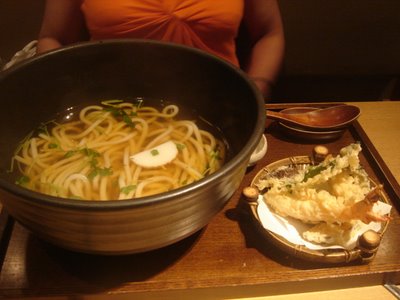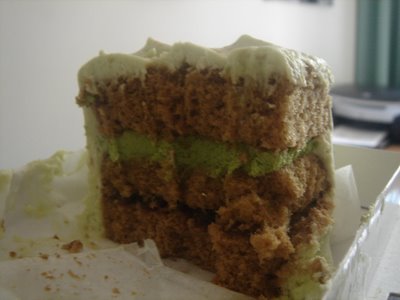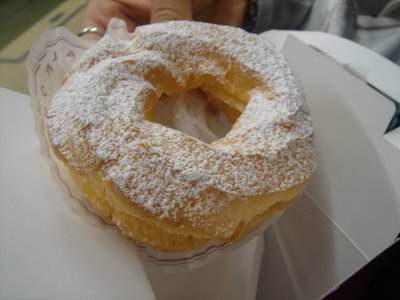Modernist Foodie
It's been awhile since I've posted. Just wanted to let everyone know I have a new blog that I've started that I'll be updating more regularly called Modernist Foodie at modernistfoodie.blogspot.com. It's a blog focused around my cooking experiments with modernist cuisine and molecular gastronomy. Check it out!
Udon Noodle House
Udon Noodle House is a cozy little restaurant located on one of the main streets in Roppongi, and we had to pass it everyday on our way to the train station. From its title you can easily guess what type of food they serve. The restaurant offers huge bowls of udon noodle soup with all kinds of fixings, and they roll up to the table piping hot – so hot, in fact, that when Sarah took a picture of me and her mom together, our faces were practically covered by the steam. We had to take at least four or five pictures before getting a decent shot. That was pretty funny.
Udon Noodle House was one of the first places I ate a meal with my girlfriend’s mother, so needless to say I was a little nervous. Having just met her for the first time in person a day before, I wanted to make a good impression. I had all kinds of concerns - don’t talk with your mouth full, wait for all the food to come before starting, don’t spill anything, use the chopsticks properly, don’t be a bumbling idiot…All these things were running through my head, but bottom line is I didn’t want to embarrass myself and play the role of the clueless American gaijin.
Still battling jetlag from the 18-hour flight and exhausted after a full day of amusement park rides at Tokyo Disneyland, I was focusing on completing some coherent sentences in conversation rather than analyzing the food at the table. I still was able to compose myself enough to take a few shots of the food, although I somehow forgot to take a picture of my own dish, which was a bowl of beef noodle soup.


I forget the exact names of the dishes, but one was essentially udon with an assortment of seafood and the other was udon in a vegetable broth with tempura on the side. We shared everything, and it was delicious, hearty, and surprisingly enjoyable even on a hot summer day in Tokyo. I can only imagine how much better it would have been in the middle of winter. The noodles had wonderful texture and were clearly made with great expertise. It’s amazing how a good noodle can sometimes save a crappy broth or sauce, but a good broth or sauce can never save a crappy noodle.
Udon Noodle House was one of the first places I ate a meal with my girlfriend’s mother, so needless to say I was a little nervous. Having just met her for the first time in person a day before, I wanted to make a good impression. I had all kinds of concerns - don’t talk with your mouth full, wait for all the food to come before starting, don’t spill anything, use the chopsticks properly, don’t be a bumbling idiot…All these things were running through my head, but bottom line is I didn’t want to embarrass myself and play the role of the clueless American gaijin.
Still battling jetlag from the 18-hour flight and exhausted after a full day of amusement park rides at Tokyo Disneyland, I was focusing on completing some coherent sentences in conversation rather than analyzing the food at the table. I still was able to compose myself enough to take a few shots of the food, although I somehow forgot to take a picture of my own dish, which was a bowl of beef noodle soup.


I forget the exact names of the dishes, but one was essentially udon with an assortment of seafood and the other was udon in a vegetable broth with tempura on the side. We shared everything, and it was delicious, hearty, and surprisingly enjoyable even on a hot summer day in Tokyo. I can only imagine how much better it would have been in the middle of winter. The noodles had wonderful texture and were clearly made with great expertise. It’s amazing how a good noodle can sometimes save a crappy broth or sauce, but a good broth or sauce can never save a crappy noodle.
Japanese Sweets and Desserts
It is said that we eat with our eyes first, our mouths second. In my opinion, there is no place on earth that has taken this more to heart than Japan. For centuries, the Japanese have been creating exquisite food, pleasurable as much as to the eye as the palette. They are masters of presentation whose creations are oftentimes so stunning that you’d rather forgo eating them than destroy something so beautiful, so perfect. Sweets (and food in general) are considered as much art as they are edible creations.
Whether traditional or borrowed from somewhere else in the world, the sweets I tried were almost always remarkable gastronomic delights, made with the care, attention to detail, and quality I have grown accustomed to finding in Japan. I was fortunate to try a number of pastries and desserts during my travels throughout the country, so I’m dedicating a full post to them. Some of the photos are shown below.

The photo above gives you a really good idea of the tremendous visual impact food can have. I took this photo at Isetan, one of the major department store chains in Japan, which sells food in addition to the typical clothes and make-up you’d expect to find. In fact, an entire floor is dedicated to food. This was just one display case of many, showcasing all kinds of sweet delights.

At Isetan, Sarah picked out quite a few cakes, and we tried them at home. One was this milk tea cake, which was absolutely delicious. The cake was surprisingly dense yet still fairly light, and the cream had a nice aromatic, Earl Grey flavor.

Another item we picked up was this green tea cake, which was extremely fluffy and had a slight bitterness to it, which I think is characteristic of chilled green tea.

Japan is the land of green tea and azuki, so naturally many desserts feature these ingredients. This was the last of the cakes we picked up from Isetan, which was essentially thin crepes with green tea cream and azuki paste sandwiched between the layers - delicious.


On our last day in Kyoto, Sarah and I stopped for an afternoon snack at a small café called Eikokuya. It had a nice patio area overlooking the grand staircase and busy travelers on the first floor of the train station. We ordered two slices of chiffon cake, one which was green tea, the other milk tea-flavored. Both cakes were amazingly light and fluffy – it was almost like eating pillows of air.

As we were walking back from one of the temples in Kyoto, we passed by a number of sidewalk vendors along a busy, tourist-laden street. This caught my eye, which was a cream puff with a green tea filling. It actually turned out to be one of the few disappointing snacks I had. The cream puff tasted a little hard and stale as if it had been sitting around, and the filling had an overwhelmingly bitter taste.


Back in Tokyo, on our way to the Meiji Jingu Shrine, we stopped into Almond, which is considered one of the best bakeries in the city. I tried one of Sarah’s favorites, choux de la crème, which was similar to a crème puff. It was light with whipped cream inside – a sweet treat to start the morning.
The Miyakes also ordered Lisa’s birthday cake from Almond, which I got to try. It was my first day in Tokyo and I arrived just as they were cutting it. I was still in a dazed stupor at that point, so I didn’t take a picture. The only thing I remember was the cake frosting tasting like maple-syrup – quite nice actually.

Hiroshima is famous for momiji-manju, which are sweet cakes shaped in maple leafs and made with all kinds of fillings. Azuki, chocolate, cream cheese, and jam are typical. The batter reminded me a little of a sponge cake. These were being sold everywhere we went, from Hiroshima station to Miyajima Island.


Sarah gave me a tour of her school’s neighborhood, and one of the areas she and friends would often go to grab lunch was Hiro-o, a quiet street with small shops and restaurants. Walking down the street, we spotted these red bean cakes, a childhood favorite of hers, being made fresh (shown above). It was nice biting into the warm and slightly chewy batter with sweet azuki paste inside.

I think we ate this fish-shaped cake in Hiroshima, but it was virtually the same in taste and texture as the one in Hiro-o.
So there you have it. I had a number of Japanese sweets, some of which were artsy and fancy and some of which were simple, humble, but nevertheless satisfying. I really enjoyed visiting Hiroshima and Kyoto and trying their local specialties. I can’t wait to go back to Japan to visit the rest of the country. I know many more tasty, undiscovered treats await.
Whether traditional or borrowed from somewhere else in the world, the sweets I tried were almost always remarkable gastronomic delights, made with the care, attention to detail, and quality I have grown accustomed to finding in Japan. I was fortunate to try a number of pastries and desserts during my travels throughout the country, so I’m dedicating a full post to them. Some of the photos are shown below.

The photo above gives you a really good idea of the tremendous visual impact food can have. I took this photo at Isetan, one of the major department store chains in Japan, which sells food in addition to the typical clothes and make-up you’d expect to find. In fact, an entire floor is dedicated to food. This was just one display case of many, showcasing all kinds of sweet delights.

At Isetan, Sarah picked out quite a few cakes, and we tried them at home. One was this milk tea cake, which was absolutely delicious. The cake was surprisingly dense yet still fairly light, and the cream had a nice aromatic, Earl Grey flavor.

Another item we picked up was this green tea cake, which was extremely fluffy and had a slight bitterness to it, which I think is characteristic of chilled green tea.

Japan is the land of green tea and azuki, so naturally many desserts feature these ingredients. This was the last of the cakes we picked up from Isetan, which was essentially thin crepes with green tea cream and azuki paste sandwiched between the layers - delicious.


On our last day in Kyoto, Sarah and I stopped for an afternoon snack at a small café called Eikokuya. It had a nice patio area overlooking the grand staircase and busy travelers on the first floor of the train station. We ordered two slices of chiffon cake, one which was green tea, the other milk tea-flavored. Both cakes were amazingly light and fluffy – it was almost like eating pillows of air.

As we were walking back from one of the temples in Kyoto, we passed by a number of sidewalk vendors along a busy, tourist-laden street. This caught my eye, which was a cream puff with a green tea filling. It actually turned out to be one of the few disappointing snacks I had. The cream puff tasted a little hard and stale as if it had been sitting around, and the filling had an overwhelmingly bitter taste.


Back in Tokyo, on our way to the Meiji Jingu Shrine, we stopped into Almond, which is considered one of the best bakeries in the city. I tried one of Sarah’s favorites, choux de la crème, which was similar to a crème puff. It was light with whipped cream inside – a sweet treat to start the morning.
The Miyakes also ordered Lisa’s birthday cake from Almond, which I got to try. It was my first day in Tokyo and I arrived just as they were cutting it. I was still in a dazed stupor at that point, so I didn’t take a picture. The only thing I remember was the cake frosting tasting like maple-syrup – quite nice actually.

Hiroshima is famous for momiji-manju, which are sweet cakes shaped in maple leafs and made with all kinds of fillings. Azuki, chocolate, cream cheese, and jam are typical. The batter reminded me a little of a sponge cake. These were being sold everywhere we went, from Hiroshima station to Miyajima Island.


Sarah gave me a tour of her school’s neighborhood, and one of the areas she and friends would often go to grab lunch was Hiro-o, a quiet street with small shops and restaurants. Walking down the street, we spotted these red bean cakes, a childhood favorite of hers, being made fresh (shown above). It was nice biting into the warm and slightly chewy batter with sweet azuki paste inside.

I think we ate this fish-shaped cake in Hiroshima, but it was virtually the same in taste and texture as the one in Hiro-o.
So there you have it. I had a number of Japanese sweets, some of which were artsy and fancy and some of which were simple, humble, but nevertheless satisfying. I really enjoyed visiting Hiroshima and Kyoto and trying their local specialties. I can’t wait to go back to Japan to visit the rest of the country. I know many more tasty, undiscovered treats await.
Subscribe to:
Comments (Atom)